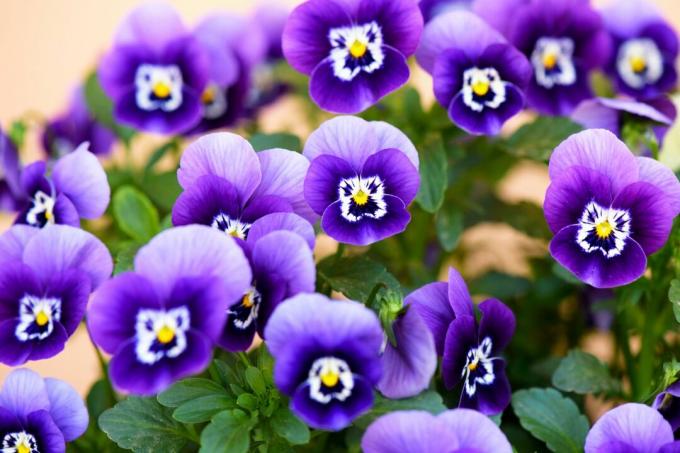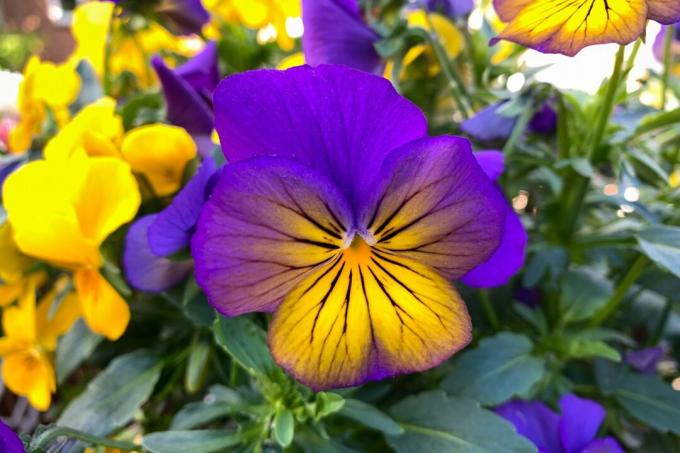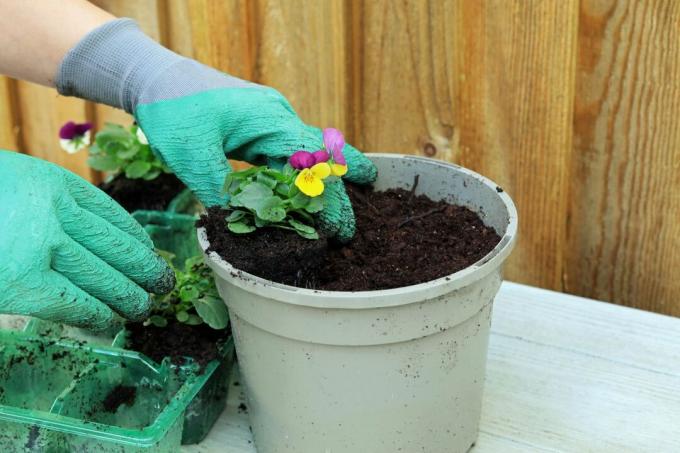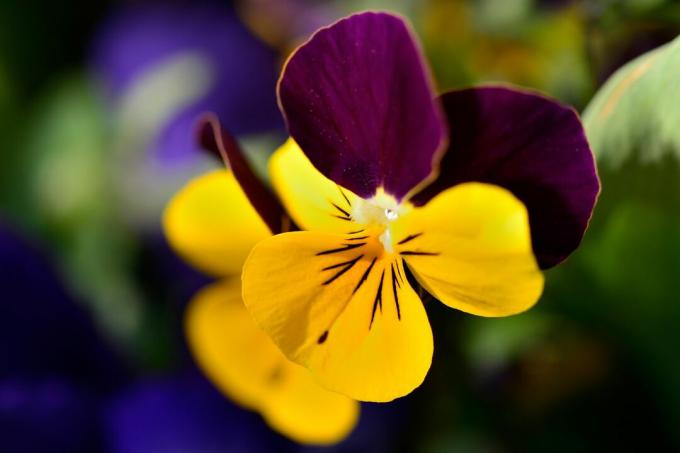Horned violets can be bought in autumn and spring. You can find out here how to care for them and what to consider when growing horned violets.

The horned violet owes its name (Violoa cornuta) a small horn perched on the end of its flower. You can also admire these flowers with their unbelievable variety of colors in your own garden from April. Planted in the right location and with a little care, you can even coax a second bloom from your horned garden dwellers.
contents
-
Plant horned violets in the garden
- Location for horned violets
- Plant horned violets correctly in tubs and beds
- socialization
-
Multiply or buy horned violets yourself
- Buying horned violets: you need to pay attention to this
- Propagate horned violets from seeds yourself
-
Caring for horned violets
- Water horned violets
- Fertilize horned violets
- Horned violets in frost
Plant horned violets in the garden
When planting horned violets you have a lot of leeway. The plants can be brought into the ground from March to October. However, it is advisable not to plant them during flowering. This can overstress the plants. Horned violets look best when planted in large groups. Then a huge color palette of flower variety can be enjoyed. The many young plants that will appear around your planted horned violets over time can be transplanted all year round. You should only make sure that the ground is frost-free.

Location for horned violets
Horned violets are originally found in the Pyrenees on rocky outcrops and alpine meadows at altitudes of up to 2500 meters. So that the plants feel good, you should choose a semi-shady location and avoid full sun. The soil should be rich in humus, loose and permeable to prevent waterlogging. In the bed, humus-rich garden soil is sufficient, also a special organic potting soil such as our peat-free Plantura organic potting soil is very suitable. If the soil is too heavy, sand is mixed in. Garden compost and horn meal can be incorporated for long-term nutrient supply. A neutral to acidic soil pH value guarantees ideal absorption of nutrients.
Plant horned violets correctly in tubs and beds
Due to their origin, the plants are ideal for rock gardens and perennial beds. Since horned violets feel comfortable in a partially shaded location, they are also great as underplanting for trees or potted standard trees. In pretty planters such as clay pots, tubs or bowls, horned violets can not only paint the garden, but also the house in your favorite colors. Care must be taken to ensure good water drainage. If you choose the right location, nothing stands in the way of the horned violets in your own garden. Whether in tubs or beds – simply proceed as follows when planting:
- Bed: Rake the soil thoroughly and remove weeds and stones
- Pot: drainage layer of potsherds, perlite or gravel; fill with suitable soil
- Planting hole: twice as big as the root ball
- Planting distance: 20 cm
- Slightly loosen the root ball with your hands
- Plant horned violets and pat down the soil
- Water well; Irrigation water with liquid fertilizer
Even when planting in a bed, a layer of gravel or grit can be laid out on the bottom of the planting hole if there is a risk of waterlogging.
notice: As underplanting of fruit trees, horned violets attract bees to pollinate the fruit tree blossoms.
socialization
Horned violets are suitable as a flowery replacement for early bloomers such as crocus (Crocus), daffodil (Narcissus) or primrose (Primula). For a varied flowering experience in summer, you can combine them with asters (aster) or zinnias (zinnia) be combined. For a second partnership in the fall, chrysanthemums (chrysanthemum) or dahlias (dahlias) can be used.

Multiply or buy horned violets yourself
Horned violets are perennial, herbaceous plants that impress with a long flowering period. If your horned violets feel really comfortable, they tend to go wild. They grow on their own, form runners and gradually take over your bed with their flowers. Who does not want to subject the propagation to the will of nature or his garden with new varieties want to spice things up, you can harvest the fruit capsules, propagate them using sinkers or buy seeds and young plants in stores to buy.
If you grow horned violets from seed, the plants are less persistent in terms of flowering time. However, the adult seedlings do not lose their willingness to flower. As a rule, they have more flowers than plants propagated using layering or cracklings. If you prefer a long flowering period, you should therefore use your horned violets propagate vegetatively or buy young plants in stores. If you prefer a lot of flowers, the plants are propagated generatively via seeds. The only decision left is whether to use your own plants as a starting point for the new generation of horned violets, or to buy seeds and plants. Purchased seeds and young plants save work and time, and if you propagate yourself, the money saved can go into the holiday fund.
Buying horned violets: you need to pay attention to this
Horned violets are available in specialist shops in spring. The young plants were grown from cuttings. After purchase, the plants are planted directly. It is important to note whether the plants come from the greenhouse. The young plants are then not used to frost. If planted before mid-May, Father Frost can still visit at night. Therefore, the plants should be acclimated to colder temperatures before planting out, or you can buy plants that have been grown in a cold house. Greenpeace also recommends buying the young plants from specialist retailers. In 2014, pesticides that are harmful to bees were found on many flowers and ornamental plants from the hardware store or supermarket, and also on horned violets.

Propagate horned violets from seeds yourself
When propagating via seeds, either commercially available seeds can be used or the seeds can be harvested from adult horned violets. You can find out how best to go about harvesting the seeds in our article “Buy horned violets or sow seeds?“. The commercially available seeds are guaranteed to be genuine. In the case of self-harvesting, this is very difficult to achieve due to the cross-breeding of the varieties. In addition, horned violets are cold germs. Self-harvested seeds should therefore be sown immediately after harvest in late summer, as they need the cold temperature period of winter. This is the only way for the seeds to germinate well and evenly. The commercially available seeds are artificially cold-treated and can also be sown in January and grown indoors. When sowing horned violets, proceed as follows:
- January – March: Sow the seeds
- Fill the open seed tray with seed soil
- Sow seeds on soil, only press lightly (light germinators!)
- Location: shady and sheltered
- Keep evenly moist
- Germination temperature: 15 - 18 °C
- Germination time: 8 days - 4 weeks
- Dark until germination, then lighter
- Transplant into small pots when the first leaves appear
- May: planting

The self-harvested seeds rest outside over the winter and are otherwise treated as listed above. The first leaves appear in spring and the plants can be pricked out. You can also sow horned violets directly into the bed until the end of September. If the seeds are sown directly into the bed, there should be a distance of 20 cm between the seeds.
Summary: Grow or buy horned violets yourself
- Advantage seeds: more flowers, cheaper
- Advantage of young plants: more persistent flowering, less time and space required
- Purchased seeds: artificially cold-treated; Sowing: January - March
- Self-harvested seeds: cold germinators; Sowing: late summer
Caring for horned violets
With a height of 20 to 30 cm, horned violets are more delicate and smaller than pansies, their relatives. Nevertheless, they are more durable and bloom longer. With the right care, the length of the flowering phase can even be maximized. Regularly cleaning out wilted inflorescences prolongs the flowering phase because the plant is not putting any energy into seed formation. When the flowering is over, a pruning supports a second one flowering of your horned violets in autumn and a bushy growth. The plant is cut back in half. Not only do you do something good for your plant, you also give your eyes more pleasure in the splendor of the flowers. After the last flowering in October, the plants are cut down to just above the ground in preparation for winter.

Water horned violets
Horned violets like it moist. Waterlogging, on the other hand, is not tolerated at all. With potted plants, a root ball that is too dense can mean that the plant does not have enough room to breathe. During flowering, the plants have a lot to do and therefore also an increased water consumption. Watering is stopped during the winter months, when the metabolism slows down. Only plants that are covered are lightly watered in winter.
Fertilize horned violets
Horned violets have only moderate nutritional requirements. If fertilized too much, they tend to grow taller and become spindly. Fertilize once in March for lush spring blooms. In order to keep a green thumb, organic fertilizers like ours are best suited for this Plantura organic flower fertilizer. They are more environmentally friendly and resource-saving than mineral fertilizers. The slower release of nutrients leads to better dosing so that the nutrients can be made available to your plants in an ideal way.
Young plants that were planted in spring or summer should also be fertilized with liquid fertilizer in the irrigation water. Our Plantura organic flower & balcony fertilizer is a purely organic organic liquid fertilizer that contains all the important nutrients for horned violets. For older plants, a second fertilization after flowering is sufficient to support the second flowering in autumn. In the winter months is not fertilized.
Summary: Caring for horned violets
- Watering: Keep soil moist, no waterlogging
- March and after spring flowering: fertilizer application
- Liquid fertilizer in the irrigation water of violets planted in spring or summer
- Pruning: cleaning out wilted flowers, pruning after spring flowering
- Winter: only lightly water covered plants; no fertilization
Horned violets in frost
Horned violets originally come from windy heights of up to 2500 m altitude. The short to biennial plants have to do a lot in winter. Most varieties can withstand temperatures down to -15 °C without any problems. Only the flowering stops in frosty sub-zero temperatures. The varieties in the 'Ice Babies' series are particularly robust. You can find out how to play it safe and protect your plants from freezing temperatures in our article Horned violets in frost.

Horned violets are closely related to pansies, but still have some differences. In this article you will find the properties of A comparison of pansies and horned violets.



